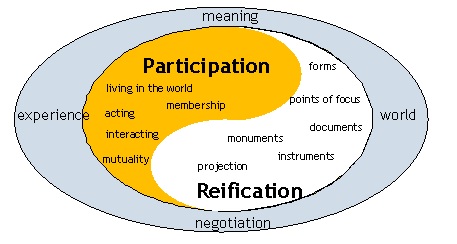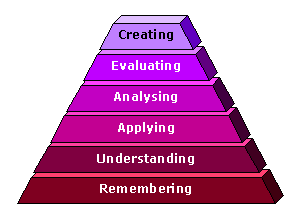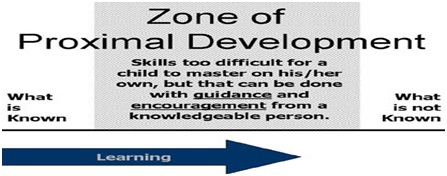The pedagogical principles of scaffolding: theoretical background and practical implementation
Abstract
Social constructive pedagogy is been used in e learning due to its nature of collaborative knowledge development, which could be effectively integrated with asynchronous learning process. In this process students may need support in certain situations and the teacher should find ways to assist them in order to maintain productive learning process. The term ‘Scaffolding’ is been used to identify such support provided by either tutor or peer students. In this paper different theoretical backgrounds of scaffolding are been discussed in order to identify the need of scaffolding. Procedural scaffolding, conceptual scaffolding, Strategic scaffolding and Meta cognitive scaffolding were further discussed with the given example of E-Teaching SV-408 course to identify the practical implementation of scaffolding in e-learning environment.
Key Words: E-learning, Social constructivism, Scaffolding, SV-408
1. Introduction
In recent decades, online education (OE) has become a driving force of quality education in many countries. OE or so called e-learning has been more popular due to its flexibility, and access, where students can join and continue the learning process anytime, anywhere at any pace. E-learning process is asynchronous with a new pedagogical approach for collaborative work in order to actively engage students to the learning process rather than been a passive reception. This has given opportunities to construct knowledge within the learning group as a collaborative activity rather than as an individual act, and emphasis on learning processes rather than memorization of information” (World Bank, 2002 cited in Bjorke, 2014a, OECD, 2009, p.294).
Despite the fact that e-learning process is flexible and accessible, those who are not familiar with this new pedagogy in online environment need support and the teacher should find ways to assist them to maintain productive learning process with high level of collaboration and knowledge construction. This could be a support, -‘scaffolding’ – given by peer students or the tutor. In this regard, the paper discuss on the theoretical background of scaffolding and its practical implementation in e-learning process. In the first phase, the paper discuss on social constructivist pedagogy of e-learning followed by a brief explanation on scaffolding. Secondly paper focus on different theoretical approaches of scaffolding in online environment. The latter part of the paper focus on practical implementation of scaffolding with a case study on ‘e-teaching ST- 408 course’ at University of Agder, Norway. Finally, paper concludes the aspects on scaffolding in e-learning environment with identified concerns on social constructivist pedagogy.
2. Social Constructivist Pedagogy
Constructivism, or learning by actively making sense of knowledge, search for meaning and construct new knowledge in interaction and cooperation with others is probably an approach better adapted to the information age than behaviorist instruction (Bjorke, 2014b). Constructivism is a theory of learning which claims that people do not passively receive knowledge transmitted from a teacher, but instead they construct knowledge and meaning from their own experiences of the world (Ben-Ari, 2001). In the e-learning process, social constructive pedagogy is been used due to its nature of collaborative knowledge development, which could be effectively integrate with asynchronous learning process. Many theorists define constructive learning theory as active construction of new knowledge based on a learner’s experience. Therefore, Social constructivism sees the individual as being engaged in learning activities with others, and tends to define learning as a social activity situated in a cultural and historical context (Bjorke, 2014b).
3. Scaffolding
Scaffolding is a necessary and one of the important part in social constructivist pedagogy, in e-learning process. students need support in order to integrate and involve with the knowledge construction in join a community of practice (CoP). As suggested by Oliver and Herrington (2001), scaffolding is essentially a teaching strategy that involves social interaction, discussion, and collaboration. Scaffolding refers to the support provided for learners to ensure they succeed in the learning environment (Horton, 2011). As per Grady, (2006), Scaffolding is those strategies that a teacher uses to help learners span a cognitive gap or leap a learning hurdle. Moreover, peer scaffolding could be used when one student who is more knowledgeable in a subject area takes on a pedagogical role to support other (Nabushawo, 2015).
Scaffolding in social constructive learning context has been defined in many different ways. However, this paper identify ways of scaffolding based on Jumaat et al’s (2014) four main types explanation mentioned below.
- Procedural scaffolding: on how to navigate the course environment and engage in learning activities. (Collaboration and cooperation).
- conceptual scaffolding: guide students with key concepts
- Strategic scaffolding: use alternative learning pathways and instruction to support individual students.
- Meta cognitive scaffolding: encourage students to do self-monitoring and self-evaluation, provide extensive assessment and feedback.
4. Theoritical approaches of Scaffolding
Scaffolding has been nourished by different conceptual paradigms and theoretical approaches based on the social constructive learning process. The five stage model developed by Salmon (2000), concept of Community of practice (CoP) (Wenger, 1998), Hierarchy of knowledge (Bloom’s taxonomy) (Bloom, et al. 1956) and Zones of proximal Development (ZPD) (Vygotsky, 1978) have given more explanation on the cognitive knowledge construction process in a group environment and the need of scaffolding. All these concepts emphasize on the importance of cooperative and collaborative learning process with the interaction and support of peer students and the tutor.
4.1. The five stage model
Salmon’s five stage module has been used in most of the e-learning processes in order to improve the social constructivist approach (see figure 1). The model emphasizes on the steps of individual learning process and activities tutors may be involved with scaffolding. Therefore, following five stage model, students gets step by step experience, knowledge and necessary support to overcome possible challenges in the online learning environment. It seemingly offers a useful paradigm for structuring, pacing and situating the developmental experiences of the course participants.
Figure 1: Five stage model

Source: Salmon (2014).
4.2. Community of practice (CoP)
Effective learning is said to be situated in activity, context, and culture as a collaboration in a community of practice (Marsh and Ketterer. 2005). CoP could be seen as social learning process which could be successfully attached to the social constructivist pedagogy (see figure 2). In a sense it is the simplest social unit that has the characteristics of a social learning system (Wenger 1998). As a result of been part of the community, there is a need of support from and within the group in order to create knowledge based on characteristics of CoP; Emergent structure, complex relationships, self-organization, dynamic boundaries, ongoing negotiation.
Figure 2: Community of Practice

Source: Atherton (2013).
4.3. Bloom’s taxonomy
Bloom’s taxonomy identifies the hierarchy of knowledge based on three learning domains (see figure 3). These three domains of learning process are: Cognitive: mental skills (knowledge), Affective: growth in feelings or emotional areas (attitude or self), Psychomotor: manual or physical skills (skills) (Bloom, et al. 1956), which explain the social constructivist learning process. They are known as pre requites for the knowledge construction process, and should follow step by step. Scaffolding by peers and teacher could enhance and accelerate with quality improvement with the achievements of the steps in Bloom’s hierarchy.
Figure 3: Revised taxonomy of the cognitive domain

Source: Atherton (2013).
4.4. The zone of proximal development (ZPD)
The zone of proximal development (ZPD) (see figure 4), is the distance between the actual developmental level as determined by independent problem solving and the level of potential development as determined through problem solving under adult guidance, or in collaboration with more capable peers” (Vygotsky, 1978, p. 86). With e-learning process, students are to develop their own knowledge with the already existing knowledge and experience, eventually lead to new constructed knowledge based on the group discussions. The concept of scaffolding describes the process of exploiting the Zone of Proximal Development (ZPD). It emphasize the need of adult guidance or collaboration of more capable peers to achieve expected level of knowledge development. According to Vygotsky (1978), Students are able to improve their learning process when they are assisted by more advanced or knowledgeable person such as teachers or peer student. Therefore, with e learning process, learning activities are designed to provide scaffolding in a social constructive environment.
Figure 4: Zone of Proximal Development

Source: McLeod (2010)
All these identifies conceptual paradigm has directly and indirectly attached to e-learning process with social constructivist pedagogy in order to improve cognitive knowledge and collaborative experience.
5. Practical implementation of scaffolding: A case study on E-Teaching SV-408 course
With the SV-408 E- teaching course, students were engaged in many learning activities (E-tivities) in the social constructive background. The purpose of the course was to produce e-tutors, provide an overview of e-teaching and give practical experience on the process. Students who participated with the programme have followed different task based on given objectives in order to improve their knowledge. Some of these tasks are directly and indirectly related to the need of scaffolding in online learning environment. In this section, the paper focuses on three identified activities which focus on three types of scaffolding.
- Task 4.2.2: Handling conflict (Procedural scaffolding)
- Task 5.2: plagiarism (conceptual scaffolding)
- Task 3.3: lurking (Strategic scaffolding)
5.1. Task 4.2.2: Handling conflict:
In this task, students were given the opportunity to manage and scaffold a conflicting environment in the online classroom. According to the task, Lily is been offended by the words of Jim and she accused Jim as a racist. Lily wants to quit the course unless Jim apologizes to her. In this situation, students discussed if the tutor should intervene to the conflict and how it should be done.
This sort of conflicts are very crucial at the first stage of group formation where there are students from different cultures, working in groups for the first time, as misunderstandings can easily arise (Hellen et al, 2015). The case study recognizes this conflict should be addressed with Procedural scaffolding where the tutor supports students to work collaboratively and maintain proper learning environment. Because a tutor has a social role to play where they have responsibility to make sure his/hers students are behaving accordingly, as well as treating each other accordingly (Daniel, 2015). Sven et al (2015) also point out that it is tutor’s job to find out what has happened and address the situation. at the situation has led to a conflict, if there is no scaffolding, there is a chance of conflict escalation into a fully-fledged racial war in the class where each side may get followers and in the end may divide or for the least derail the purpose of the study debate (Mukisa, 2015 ). Apart from scaffolding both Jim and Lily, tutor should encourage all the participants to think through the incident and try to learn from the experience (Brunch et al, 2015).
5.2. Task 5.2: plagiarism
In this task, Peter from Kenya and Rita from Greece are been suspected for plagiarism and students were supposed to discuss on how to check this and how to react on it. This task is been identifies as a discussion for conceptual scaffolding as the given situation has emphasize on the lack of knowledge on plagiarism and therefore tutor should take action in order to educate students in the given concept and improve their academic integrity. Asiri et al (2015) also point out that if the teacher has much more closer relationship with the students, then scaffolding and giving feed backs to improve academic integrity is a good reaction, as teacher can warn the students as well as advice on possible issues arise with the plagiarism. Dianah et al (2015) also stated that it is the tutor’s responsibility to support Peter and Rita (Dianah et al, 2015). In this case however, the most important scaffolding method is to teach students what plagiarism is, how to paraphrase and summarize, how to use quotations (Nuwagaba, 2015).
5.3. Task 3.3: Lurking
In this task, Two of the students, Sophie and Will are lurking in an asynchronous discussion and students discussed on contacting them in order to increase their participation. This activity leaded to strategic scaffolding as the tutor need to identify the individual needs and situation of Sophie and Will and support and motivate them to engage with the learning process.
In order to achieve successful e- learning process, tutor should understand the differences of learning and level of understanding of individual students with the given pedagogical approach. As per the view of Teo et al (2006), E-learning pedagogy is one that incorporates this form of learning pedagogy but goes beyond it to include a deeper study into the incorporation of instructional strategies that take into account real-time personalized learning content-to-learner adaptability Individualized or personalized support is of utmost importance to e-learning (Teo et al 2004). According to (Mukisa, 2015a), there is a need for scaffolding in this situation, so that students do not feel left out and eventually dropping out.
With these identified case studies, it is significant that there are many situation students need support regarding the procedure, concepts, strategies and Meta-cognitive development. In a higher learning environment, students should be allowed to construct their knowledge based on their own experiences and interaction with other students. However, in such conditions, support (scaffold) from the tutor and the peer students are a must and previously discussed case study provides evidence to attest the statement.
6. Conclusion
In the e-learning process, social constructive pedagogy is been used due to its nature of collaborative knowledge development, which could be effectively integrate with asynchronous learning process. Despite the fact that e-learning process generates cognitive knowledge, students may need support in certain situations and the teacher should find ways to assist them in order to maintain productive learning process. Procedural scaffolding, conceptual scaffolding, Strategic scaffolding, Meta cognitive scaffolding are different scaffolding ways to be used in such environments. Practical implementation of scaffolding with the case study on E-Teaching SV-408 course provided examples on the need of scaffolding in e-learning environment.
References:
Alias, N. A. (2012). Design of a Motivational Scaffold for the Malaysian e-Learning Environment. Educational Technology & Society, 15 (1), 137–151.
Asiri (2015). Asiri : jot down. in.,Asiri, et al. Task 5.2. UIA
Asiri et al (2015). Plagiarism. UIA
Bjorke, S.A. (2014a). Online education – a driving force for quality in education.
Bjorke, S.A. (2014b). Asynchronous Computer Conferencing is ideal for collaborative learning.
Bloom, B.S. (Ed.). Engelhart, M.D., Furst, E.J., Hill, W.H., Krathwohl, D.R. (1956). Taxonomy of Educational Objectives, Handbook I: The Cognitive Domain. David McKay Co Inc
Buinch et al (2015). SV-408 Task 4.2.2. UIA.
Chao Boon Teo, Robert, Kheng Leng Gay (2004). Concept Map Approach to E-learning.World Conference on E-Learning in Corp., Govt., Health, & Higher Ed., Vol. 2004, Issue. 1, 2004, pp. 2160-2165
Daniel (2015) Intervene? Yes, In Brinch. Task 4.2.2. UIA
Dianah et al . (2015). Task 5.2 Handling Peter and Rita Plagiarism Case. UIA
George E. Marsh , John J. Ketterer. Situating the Zone of Proximal Development . Online Journal of Distance Learning Administration, Volume VIII, Number II Summer 2005
University of West Georgia.
Grady,H.M., (2006). Instructional Scaffolding for Online Courses.
Hellen et al (2015). Module 4 Task 2.2. UIA.
Horton, W. (2005). Leading e-learning. ASTD
Jumaat, Nurul, Farhana & Zaidatun, Tasir (2014). Instructional Scaffolding in Online Learning Environment: A Meta-Analysis. Presented at the 2014 International Conference on Teaching and Learning in Computing and Engineering. doi: 10.1109/LaTiCE.2014.22
Mukisa(2015a). Just to add on . In. Mudondo et al. Task 3.3, Deadline is 20th
Mukisa. (2015). Tutor should intervene. in.,Mukisa et al. Task 4.2 Activity 2: Handle conflict.UIA.
Nabushawo (2015). Scaffolding Task 4.2.1. In. Moxnes et al. Assignment 4.2.1 – Scaffolding, DEADLINE 20.11.UIA.
Nuwagaba (2015). The pressure on students,whether academic. In. Thormodsæter et al., 5.2 Plagiarism. UIA.
OECD (2009). Educational Research and Innovation Higher Education to 2030, Volume 2, Globalisation. OECD Publication.
Oliver, R., & Herrington, J. (2001). Teaching and learning online: A beginner’s guide to e-learning and e-teaching in higher education. Edith Cowan University Publication.
Sven, et al (2015) 4.2.2 Conflict, module4. UIA.
Teo, C.B., Chang, S.C.A. Gay ,R.,Leng, K. (2006). Pedagogy Considerations for E-learning.
Vygotsky, L. S. (1978). Interaction between Learning and Development. In M. Cole, V. John-Steiner, S. Scribner, & E. Souberman (Eds.), Mind in society: the development of higher psychological processes (pp. 79-91). Harvard University Press.
Wenger, E. (1998). Communities of practice and social learning systems: the career of a concept . Etienne.